The OnePlus 3 Review
by Brandon Chester on June 20, 2016 8:00 AM EST- Posted in
- Smartphones
- OnePlus
- OnePlus 3
System Performance
2015 was not a great year for Android devices. Snapdragon 810’s problems with throttling severely crippled the performance of high end smartphones. In the case of the OnePlus 2, OnePlus went even farther by putting in code that would detect when Google Chrome was in use and completely shut off the A57 cluster on the SoC. This resulted in web browsing performance that was essentially no better than what you’d find on a $100 phone shipping with Snapdragon 410, which simply wasn’t acceptable given the fact that the OnePlus 2 was priced at around $400.
Like most of this year’s flagship Android devices, the OnePlus 3 uses Qualcomm’s Snapdragon 820 SoC. We looked at Snapdragon 820 not long ago in the LG G5 review and saw that it provided a substantial improvement over Snapdragon 810, which became even greater when you consider prolonged workloads where Snapdragon 810’s A57 cores throttle down and shut off. Given that OnePlus no longer has any reason to put in strange app detection code to manage thermals, we should see a good uplift in general performance and an enormous improvement in web performance.
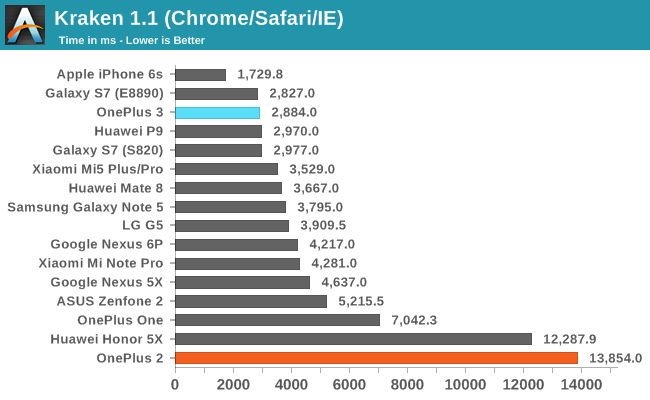
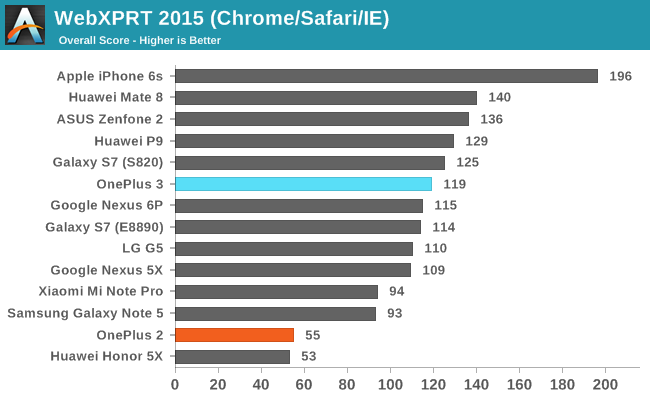
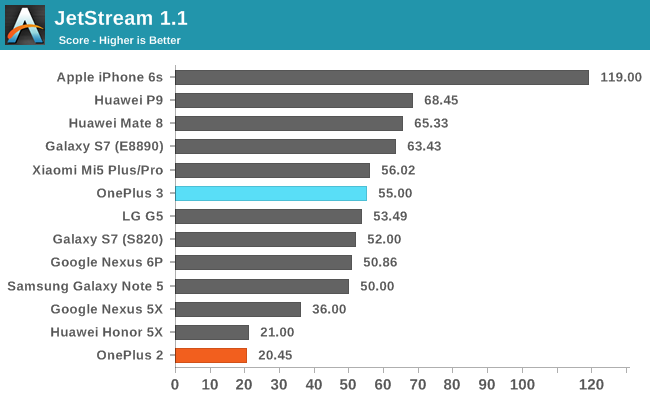
The improvement in web browsing performance when going from the OnePlus 2 to the OnePlus 3 is staggering. This isn't unexpected when you consider that the OnePlus 2 was just running on Cortex A53 cores that were meant for low power scenarios while the OnePlus 3 is using Qualcomm's Kryo cores. In Kraken the OnePlus 3 is over four times faster, while in WebXPRT and JetStream it's at least over two times faster. The OnePlus 2 actually represented a large regression in web performance compared to its predecessor, and OnePlus has brought web performance back to a level that is competitive with the other smartphones on the market with the OnePlus 3.

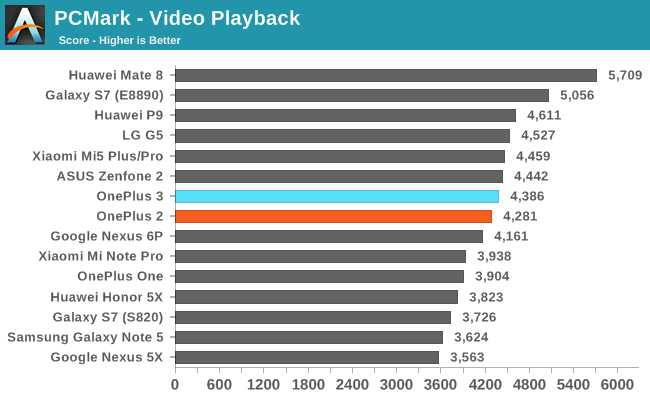

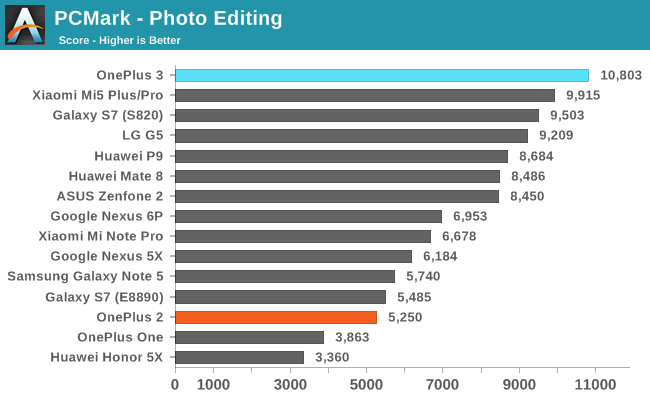
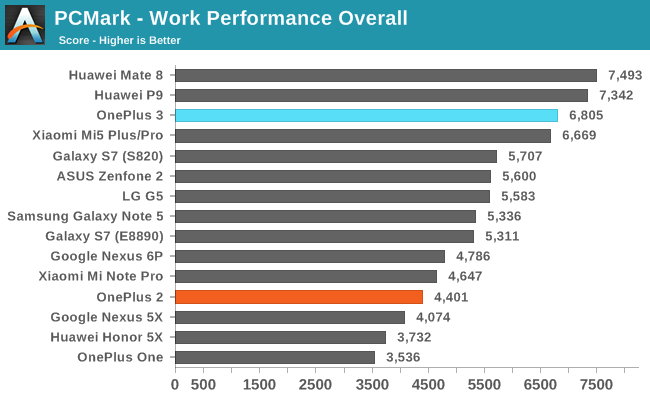
PCMark is an interesting test because it depends just as much on a phone's software as it does on the hardware. We've seen how devices with the same SoC can perform very differently, especially in certain sub-tests like the Writing and Photo Editing tests where different runtime and OS optimizations can have a large impact. The OnePlus 3 is no exception, with it achieving higher scores than the LG G5 in every test except for video playback where they have roughly the same scores.
This is not unexpected, as it was demonstrated in the LG G5 review that the G5 has more conservative frequency scaling than the other Snapdragon 820 devices that we've seen, which is reflected in PCMark's tests. In any case, the OnePlus 3 actually gets close to the Huawei Mate 8 in the writing test, and beats it and the LG G5 by a large margin in the photo editing test. In the end the OnePlus 3 places second on our overall chart, with only the Huawei Mate 8 ahead of it, and the gap between it and the Mate 8 being smaller than the gap between it and the Zenfone 2 which is the next fastest smartphone.
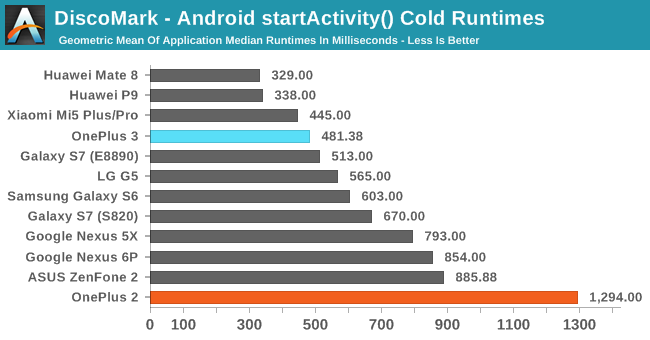
The OnePlus 3 is over two times faster than the OnePlus 2 with cold app launches where the application isn't resident in memory in any state. This is likely a combination of improved NAND performance, and changes to OnePlus's DVFS settings in addition to the performance improvements that Snapdragon 820 provides on its own. The impact that this has on the performance of the interface is significant, and when I reviewed the OnePlus 2 I noted how painfully slow it was to move around and through the applications. This new testing is a great example of that, with the OnePlus 2 taking 1.3 seconds just to launch apps, while the OnePlus 3 takes under 500ms and is the second fastest device here.
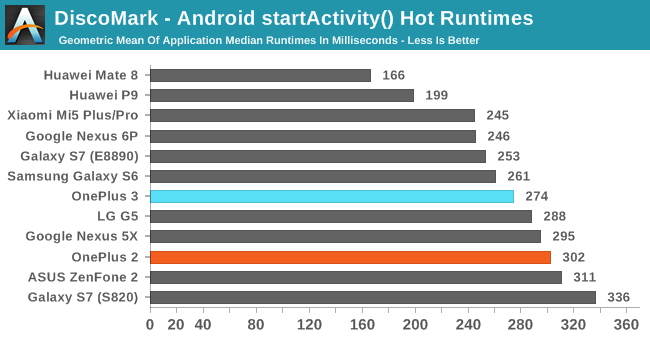
The OnePlus 3 improves a bit over the OnePlus 2 when resuming apps that are resident in memory, but not by a great deal. In general, all our devices hover between 250 and 300ms here, with the exception of the Huawei Mate 8 and P9 which are really in a category of their own for performance. While there's no enormous improvement here, the OnePlus 3 is competitive with other high end devices in the market, so there's nothing to complain about either.
One thing worth noting is that our set of apps wouldn't come close to utilizing the OnePlus 3's 6GB of RAM. Unfortunately, no matter how many apps we added, this would actually still be the case. The reason is that OnePlus has implemented very aggressive app eviction from memory, which means that your 6GB of RAM is really just sitting there using energy, and in general the utilization is pretty low. This may be a holdover from when the OnePlus 2 shipped in a 3GB configuration, but it's something OnePlus needs to address in a future OTA update. I'd imagine the Android enthusiast community is already at work on, or has already created custom kernels to alter this behavior as well. With 6GB of RAM you should be able to comfortably keep all of a user's frequently used apps resident in memory.
It's great to see that OnePlus is producing a smartphone with competitive performance once again. When the OnePlus One launched, Snapdragon 801 was the best you could get in an Android smartphone. The OnePlus 2 was an unfortunate victim of Snapdragon 810's heat and throttling problems, but OnePlus certainly didn't help the issue by hardcoding in mechanisms to detect Google Chrome and shut the A57 cluster off entirely. With the OnePlus 3 you get some of the best CPU performance in an Android phone, with PCMark's real-world tests demonstrating noticeable gains over the LG G5 which also uses Snapdragon 820. If I had to sum things up in a single line I'd just say that it's good to see that OnePlus is back in the game.


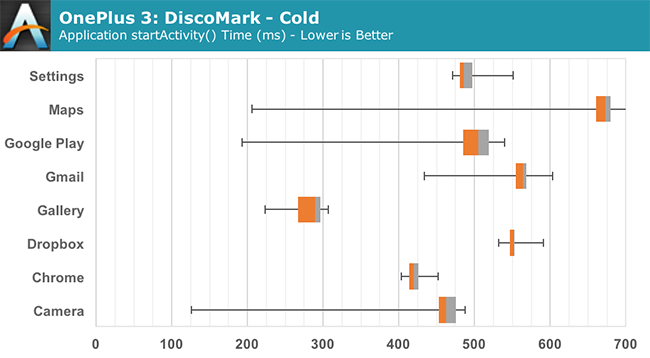
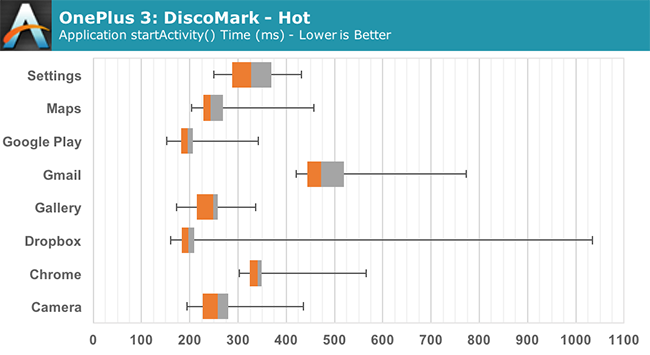








176 Comments
View All Comments
UtilityMax - Wednesday, June 22, 2016 - link
Sadly, in the world of Android the competition has forced the companies to start hyping the features nobody asked for, such as QHD screens, octa-core processors, and now I guess RAM (6GB of it, no less). At the same time, the Android vendors often fail to deliver features people really wanted, such as better battery life, quality screens (as in good brightness and black levels, at least), sd card slots, unlocked wireless bands, and single-core performance that could match at least the three year old Snapdragon 800/801 at an affordable price.fanofanand - Monday, June 20, 2016 - link
I seem to recall them highly lauding the Moto-G, and even the Moto-E. Your complaints are largely invalid, as they do take price into account. They are technical reviewers, if they started every sentence with a caveat about price it would be unbearable reading. "Xiaomi showed us with the Redmi note 3 pro that a 4000 battery is possible with a $200 or less phone".Then go buy the Xiaomi. If you think that phone is the bee's knees then vote with your wallet. If a massive battery is the sole important factor in your phone purchasing then your search is over! For the rest of us, it's nice to see the technical analysis and decide for ourselves what amount of compromise is worth the cost savings.
FWIW I am on my 2nd Nexus 5 because no company has made anything since that is a better value. I get the value proposition, I do.
thek - Monday, June 20, 2016 - link
You obviously didn't understand the argument, sir.The point was that if even a low end cheap Chinese phone can have better batteries, than huge companies can include them too. But they don't. So why is that?
fanofanand - Monday, June 20, 2016 - link
Maybe because there are no employee protections in China? Maybe because there are no real consumer protections in China? The cost of doing business as a Chinese company is a fraction of the cost of doing business in the EU or the US. There is a reason most Chinese products don't get sold in either of those two markets, and it isn't just patent/copyright laws. You might as well ask yourself why you can buy 10 Chinese t-shirts for the same price of one US made t-shirt. BOM is not static between nations.thek - Monday, June 20, 2016 - link
You do realize that the IPhone is made in China right?..You missed it again: the correct answer was that those companies are being cheap on us consumers, even on their premium priced flagships because they want to keep making billions of dollars of revenue per quarter (not even talking yearly!!).
they can provide 64GB as base storage and 4000+ batteries as minimum. They just don't want to.
melgross - Monday, June 20, 2016 - link
Ah, you're missing the point. Quality manufacturers all pay about the same thing for the same things. A screen may be made by one manufacturer, but their customers may spec a lower, or higher quality for brightness, speed, color quality, contrast, power draw, and other matters.The same thing is true for everything else. There are higher quality batteries, and lower quality batteries. The better ones may last for 1,000 recharges, and the cheaper ones may just last 500. Storage is, again, the same. Apple obviously uses higher quality NAND, hence the much higher speeds. It's been said elsewhere too. When making cheaper phones, compromises must be made. Not spending the money to calibrate a screen is a factor that we see here. Even if they come out with an sRGB update, without calibrating each screen, it will still look pretty bad. Cheaper components and fewer features are the way to go. How a manufacturer balances that all out is the differentiating factor.
kurahk7 - Monday, June 20, 2016 - link
Here are a few reasons why the display is the single most important part of a smartphone-1. You stare at it all day long.
2. The image that you see while taking a photo is expected to be the same as when you print it out or share to a friend.
3. You will be able to enjoy content the original creator intended.
echoe - Monday, June 20, 2016 - link
I mean, if a phone didn't have a working display it would not be usable. The screen needs to be good. They mention the caveats to this judgment in the review, but obviously it's pretty bad ...UtilityMax - Wednesday, June 22, 2016 - link
Why do you think that 400USD is not enough money for the vendor to deliver a quality screen? In fact, the vendors have gotten quite lazy recently. The 600+ USD prices were artificially inflated to herd the consumers into signing the multi-year cellular plans so they got big discounts on hardware. Now that the heavy discounting of the locked carrier-branded smartphones by the carriers is nearly gone, I don't know what's going to keep justifying the 500-600USD prices on the flagship phones when a phone like Nexus 5X offers 90% of functionality, at 40 percent discount. The Nexus 5X normally sold for well under 400USD. It had a great display and great camera, and was basically a good all-around phone. Yes, the SoC was slower than that in OP3, but that issue affected most phones of the 5X generation.The_Assimilator - Monday, June 20, 2016 - link
Hey look it's... not a GTX 1080 review.